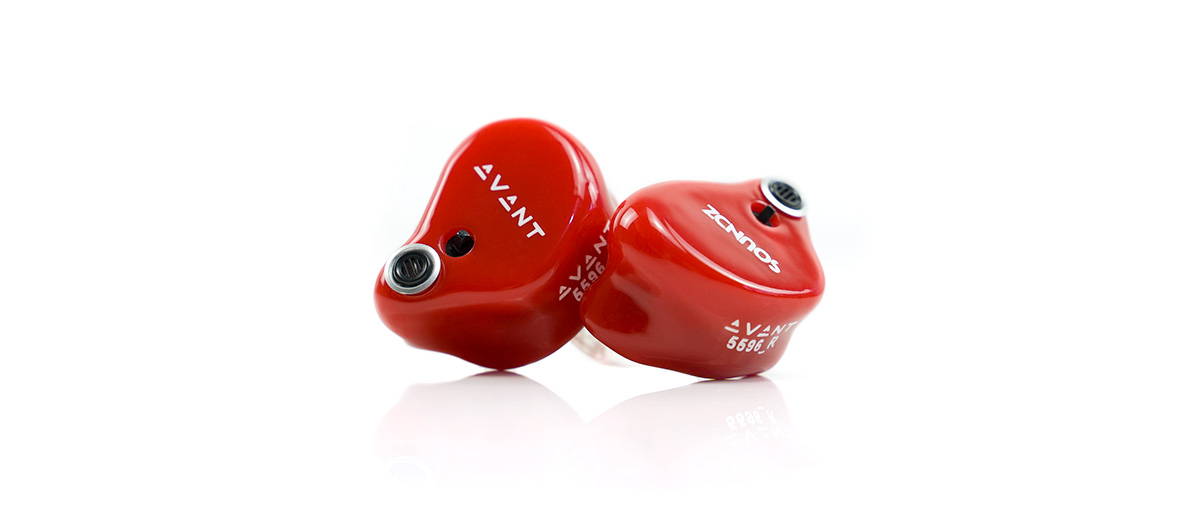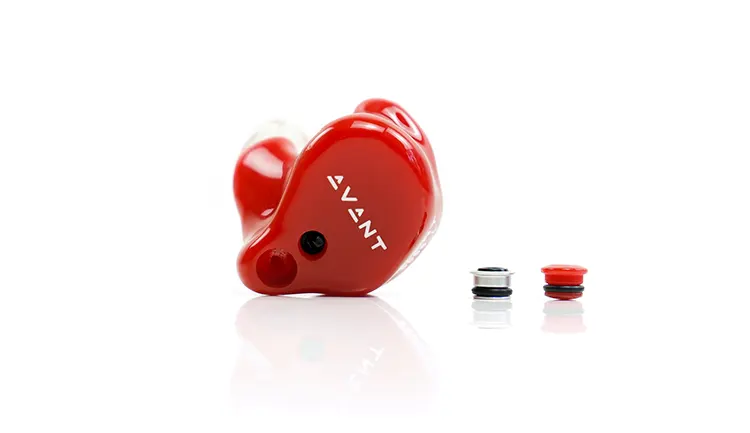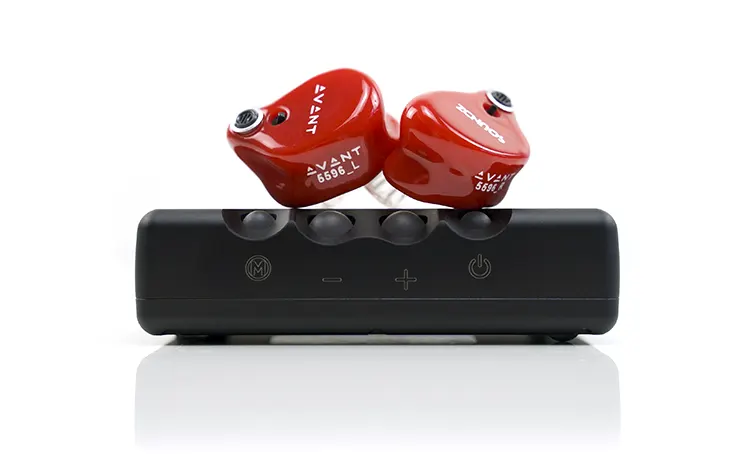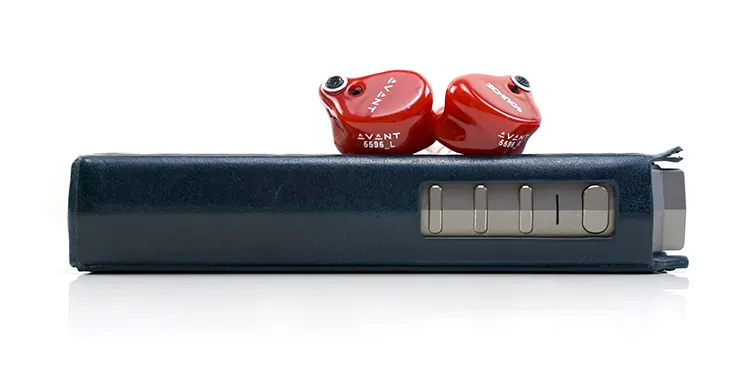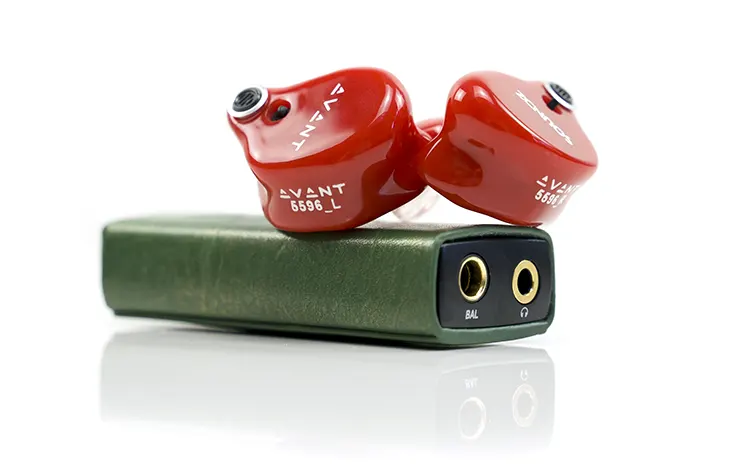Sound Impressions
The following impressions were created using a mix of the HiBy RS8 and the Chord Electronics Mojo 2 and the main sources combined with the Avant stock cable and switching between the Edge Ambient -17 dB and total block filters.
Summary
The Avant has a number of tuning profiles, more so if you are lucky enough to have a mold compatible with the Edge filter system that will throw in a few more on top of the Immersive Mode dual sound signatures.
At its heart though is a ‘joyful’ and articulate tuning with a strong focus on PRaT, surprisingly good low-end power, and a clear vocal presence.
With the Immersive Mode off the Avant lows up to about 800Hz stay relatively neutral and inoffensive allowing the stronger 1-4k region to take primary focus. Sibilance and fatigue are kept in check with a subtle treble attenuation that stays just a bit below the Harman Target curve ideal dB levels.
Turn on that mode and everything up to the same 800hz level gets a few dB of lift, particularly from 200Hz down to 20Hz with everything above 2-3k relatively unchanged, maybe 1-2 dB at most in the upper-mids around 3-4k to create a warmer more powerful sound signature.
In a way it is almost an ‘old school’ approach though by old we are maybe going back 3-4 years at most to models like the qdc Anole V6 that offered a similar pitch.
Although I find the Avant more detailed and refined than the Anole V6 the emotional connection is similar with the bass fundamental and vocal ‘touchpoints’ emphasized rather than aiming for a pure reference or linear-type tuning.
Filter Tweaks
If you do happen to get the Edge filters this will change things a bit more and might appeal more to those who enjoy the more modern focus on creating space and relaxing the mid-focus a bit in the process.
With the -17 dB version the width and height open up improving the separation and air and giving you a bit more of an ‘atmospheric’ quality to the soundstage.
Whereas the total block filter will bring everything in a bit and shift more attention to the bass weight and vocal immediacy. Kind of like moving from a dance hall or small arena to a studio in terms of size.
Frequency Response
There are technically two core frequency responses available; the Immersive Mode on and Immersive Mode off. However, both follow a similar curve with the main difference being the amount of dB emphasis from 20Hz up to around 800Hz.
The core tuning loosely follows Harman principles but with some additional 1-4k emphasis and a 100Hz to 300hz lift that is more noticeable with the Immersive Mode on than off.
The sub-bass response in Immersive Mode is excellent for an all-BA driver setup though, in truth, BA woofers have improved a lot over the years, (see page 3 and our Westone Audio ES80 comparison for a good example of this).
It still is maybe 1-2dB below the ideal curve 50Hz downwards but in truth, you really wouldn’t want any more emphasis or the delicate balance with the mids might get lost.
The additional 100-300Hz emphasis when Immersive Mode is active introduces some bloom and warmth and you can notice that right away in the lower-mids compared to the flatter tone when the Mode is turned off.
There is still a noticeable dip in the lower-mids from around 600Hz to 1k to keep the bloom from creeping up too much though the 1-4k peak is fairly substantial giving vocals clear priority over most backing instruments.
From 5k onwards you get a gentle attenuation, slightly below the Harman Target but still quite linear in its drop with some nice extension from that quad-BA array ensuring there is sufficient headroom.
Timbre
The duality continues with the Avant coloration and to be honest I much prefer the heightened saturation from the Immersive Mode turned on.
That additional warmth and weight on the Avant lows when the Immersive Mode is turned on gives lower-pitch instruments some necessary gravitas and provides a proper counter to elevated 1-4k range as well as a smoother vocal tone.
When turned off the general tone is neutral to natural with a lighter touch but still, some nicely balanced highs giving percussion timbre a very likeable harmonic balance.
I would argue though that the overall note weight is still slightly on the neutral side, especially with the dipped lower-mids when compared to monitors like the darker and more rounded Maven Pro.
It also offers more contrast in its coloration than the richer midrange delivery of the Anole VX with all its dip switches in the on position.
However, I honestly do not mind that because the low-end on the Avant is an absolute joy with Immersive Mode on. It punches nicely, and offers outstanding reach for a BA woofer, and that additional weight gives it everything below 1k with such a gloriously planted and lively effect.
On the flip side, the 1-4k range can dominate with source pairings accentuating or calming the effect. Thankfully, Soundz has seen fit to drop the Avant treble aggression to keep the forward vocal experience quite balanced tonally rather than overly dry and harsh sounding.
I honestly never found any random sharpness in percussion passages or unnatural vocal sibilance creeping through, even with more neutral sources.
Staging & Dynamics
This is where those Edge filters will play a more defining role in shaping the Avant soundstage.
With the total block filter, it’s an intimate soundstage with bass and anything crossing that 1-4k range upfront and dominating your attention. The effect is more akin to a studio experience with not a huge amount of vertical expansion but with strong depth and a forward vocal presence.
Using the total block filter combined with the Immersive Mode turned off the power and depth will drop back giving the presentation more of a midrange bias or slightly flat presentation save for a gentle nudge from the mid-bass punch.
With the Edge filter the presentation is filled with air, the presence region imaging becomes a little more relaxed and the overall perception of instrumental separation improves substantially.
Moving from the Edge filter to the total block filter is like moving from a studio to a medium-sized hall in terms of performance acoustics though I still would not classify the Avant as offering a massive soundstage per se.
Synergy
Efficiency
The Soundz Avant is rated at 16.2Ω impedance with a sensitivity benchmark of 105 dB/mW @1kHz for SPL. This is not a terribly difficult monitor to drive from either a DAP or a dongle in both SE and balanced output mode where applicable.
Still, it is a little less efficient compared to similar 10 BA driver models such as the qdc Anole VX which is rated at 110-112 dB @1kHz 1Vrms but more or less on par with the hybrid EST Maven Pro at 30Ω and 112dB SPL @1KHz. I always have a feeling EST drivers can tax an output a little more than without.
The Avant is hugely more sensitive than the Westone Audio ES80 which has a sensitivity rating of 111 dB @1kHz 1 mW. That colossal 80Ω impedance rating of the ES80 really requires you to up the volume considerably to match the Avant but more importantly, you do need some quality voltage to feed the ES80 to get it sounding optimal which is not the case with the Avant.
Also, the Avant is not so sensitive to pick up background hiss. I did pick up some EMF whilst charging a DAP but that was the same for all of the compared models so not something to be concerned about.
I would perhaps suggest grabbing the Avant with a balanced plug rather than SE, simply because the majority of portable sources tend to chuck out more power than their SE PO which will improve the perception of channel separation and dynamics. That being said, the Mojo 2 was an excellent pairing with the SE stock cable that I received.
DAP Pairings
I tested 4 DAPs with the Soundz Avant including the HiBy RS8, the N8ii, and the N7 from Cayin, as well as the FiiO M15s, all with the stock single-ended cable.
Out of that selection, my takeaway was the bass response both in terms of quantity and quality and how each DAP shaped it relative to the rest of the performance.
Of the four, the RS8 and the N8ii provided the highest quality bass performance from the Avant both in terms of dynamic response and definition with the RS8 just a shade tighter to my ears and a little less warm. Of these two, the RS8 will push the vocal range the least forward.
I will throw in the Mojo 2 here also as a very good SE option for the Avant for both technical capability and tonal neutrality. The dynamic snap from the Avant on the lows was on par with the RS8 and N8ii but its mids and highs offered a bit more contrast and sparkle creating a cleaner more precise tone.
The surprise was the FiiO M15s/Avant pairing when ranged against the N7. Its low-end was more colored, weightier, and frankly more fun sounding compared to the N7 which always felt restrained and too controlled, especially on the sub-bass.
Now the M15s does fall behind the N7 in terms of separation and staging space lacking the same excellent headroom and creating a very bottom-weighted and strong forward vocal focus. If you want something more balanced but still retain a fairly analog overtone then the N7 is the better pairing.
Dongle Pairings
Again, going with 4 dongles and judging primarily on how well-defined and responsive the low-end of the Avant was relative to the rest of the presentation. Those four dongles included Cayin’s RU7 and RU6, as well as the HiBy FC6, and the Questyle M15.
I have to say I was very disappointed with the M15 performance single-ended. It’s nowhere near as dynamic and incisive as its balanced output equivalent and of the 3 dongles it created the blandest bass performance from the Avant.
The presence and lift were there but the texture was lacking in detail and the edges were less well-defined compared to the best of the performers, the RU7. The R7 got on top of the Avant lows, creating excellent texture and a lot of staging depth for them to breathe.
The balance felt correct with the R7 both in terms of depth and width with nothing overly emphasized which is great for a monitor like the Avant which has a robust 1-4k range to begin with.
And that is where the RU6 fell down. It’s a smooth tone, more textured than the M15 but the vocal emphasis it tends to tease out dominates the mix to a distracting level. Thankfully, the euphonic coloration it brings doesn’t overly fatigue but background notes can be firmly behind the vocal on the Avant with this pairing.
The HiBy FC6 was the darkest of the dongle pairings. On its NOS setting the bass was more powerful than the other dongles but could get a bit messy and overpowering at times. Vocals were strong also but with less headroom and sparkle from the Avant.

